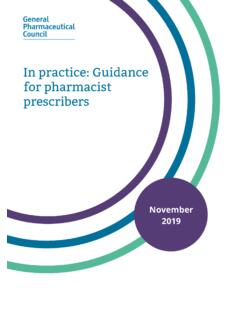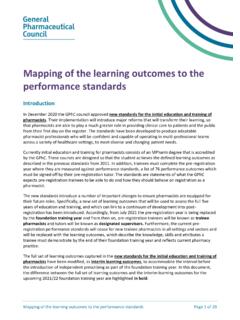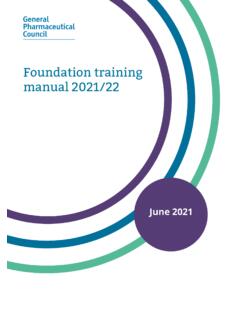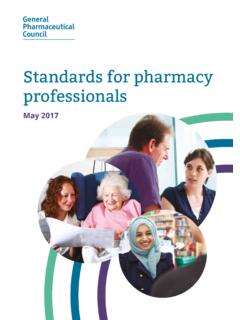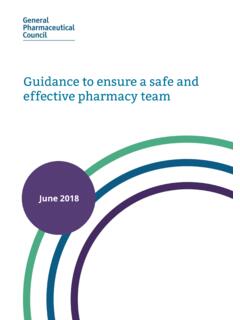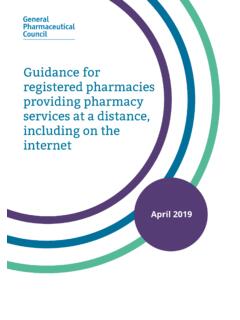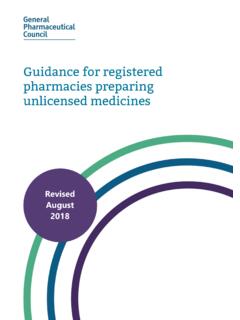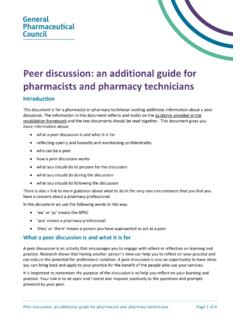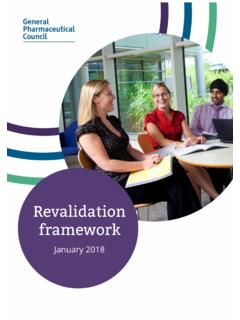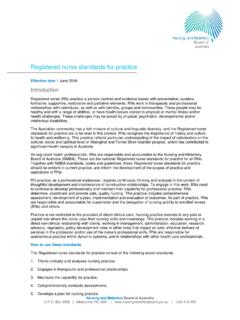Transcription of Future pharmacists Standards for the initial education and ...
1 Future pharmacists Standards for the initial education and training of pharmacists May 2011. Contents The delivery of education and training 6. Requirements for the initial education and training of pharmacists 7. Standard 1 Patient and public safety 8. Standard 2 Monitoring, review and evaluation of initial education and training 11. Standard 3 Equality, diversity and fairness 14. Standard 4 Selection of students and trainees 16. Standard 5 Curriculum delivery and the student experience 18. Standard 6 Support and development for students and trainees 23. Standard 7 Support and development for academic staff and 25. pre-registration tutors Standard 8 Management of initial education and training 27. Standard 9 Resources and capacity 29. Standard 10 Outcomes 33. Appendix 1 Indicative syllabus 45. Appendix 2 European requirements for the initial education and 54. training of pharmacists Appendix 3 National and European requirements for master's 56.
2 Level qualifications Appendix 4 Sites for pharmacist pre-registration training 58. Further information 59. Future pharmacists : Standards for the initial education and training of pharmacists 3. Future pharmacists Standards for the initial education and training of pharmacists This document provides schools of pharmacy1 with the Standards for the initial education and training of pharmacists . The requirements for submitting a degree for accreditation are in our accreditation and recognition manual, which is published separately. This document may also be of interest to prospective and current pharmacy students and pre-registration pharmacist trainees, those involved in the initial education and training of pharmacists , pharmacy professionals and members of the public. 1 The term school of pharmacy' is used throughout this document. It is used generically to describe the academic unit in a university with primary responsibility for delivering an accredited course.
3 Depending on institutional structures a school' may be a school, department, division, faculty or other grouping. Whatever its name, for accreditation purposes a university must define the unit with primary responsibility for delivering an accredited course. 4 Future pharmacists : Standards for the initial education and training of pharmacists About us The General Pharmaceutical Council (GPhC) is the regulator for pharmacists , pharmacy technicians and pharmacy premises. It is our job to protect, promote and maintain the health, safety and wellbeing of members of the public, and in particular those members of the public who use or need the services of pharmacy professionals or the services provided at a registered pharmacy. Our principal functions include: setting Standards for conduct, ethics, proficiency, education and training, and continuing professional development (CPD);. establishing and promoting Standards for the safe and effective practice of pharmacy at registered pharmacies.
4 Establishing fitness to practise requirements, monitoring pharmacy professionals' fitness to practise and dealing firmly and fairly with complaints;. approving qualifications for pharmacists and pharmacy technicians;. maintaining a register of pharmacists , pharmacy technicians and pharmacy premises. We will aim to ensure that regulation is fair and proportionate that is, in line with the level of risk posed to public health, safety and wellbeing and not over-burdensome. We want it to be flexible enough to respond to the changing demands made of the profession and to allow for innovation at the same time as maintaining high quality practice. Future pharmacists : Standards for the initial education and training of pharmacists 5. The delivery of education and training The initial education and training of pharmacists in Great Britain is: Four-year MPharm degree (or five-year MPharm degree 52 weeks of pre- Registra on Health, character Registra on as a including registra on Assessment and iden ty checks pharmacist intercalated training (Examina on).)
5 Blocks of pre- registra on). In Great Britain the four-year MPharm degree is separate from the 52-week pre-registration training with one exception: a five-year MPharm degree with two intercalated periods of pre-registration training. We expect the MPharm degree plus pre-registration training model to predominate in the short term, with an integrated degree combining academic study and pre-registration training being a Future possibility. However, these Standards have been written in such a way that they could support an integrated degree because we have not been prescriptive about delivery structures. The outcomes in Standard 10 refer to outcome levels for an MPharm degree and outcome levels for pre-registration training. Unless a school of pharmacy decides to offer an integrated degree, the pre-registration outcomes are for reference and course design purposes only. As schools are not responsible currently for delivering pre-registration, anything related exclusively to pre-registration has been italicised for It should be borne in mind, however, that even though most MPharm degrees are separate from pre- registration training, they are a preparation for it.
6 2 Titles of documents have also been italicised. 6 Future pharmacists : Standards for the initial education and training of pharmacists Requirements for the initial education and training of pharmacists For students studying in Great Britain, there are three routes to registration3,4. as a pharmacist, either a four-year MPharm degree (part of which may be studied overseas); then 52 weeks of pre-registration training; and our Registration Assessment (an examination). Normally, this route to registration must be completed in eight years. Or a two-year part-time foundation degree in pharmacy5 (comprising year 1. of an MPharm degree plus work experience and study skills); then years 2 to 4 of an MPharm degree; then 52 weeks of pre-registration training; and our Registration Assessment (an examination). Normally, this route to registration must be completed in nine years. Or a five-year MPharm degree, including intercalated blocks of pre- registration training equalling 52 weeks; and our Registration Assessment (an examination).
7 Normally, this route to registration must be completed in eight years. 3 The maximum period for completing a route to registration may be adjusted pro rata for periods of part-time education or training and for other legitimate, documented reasons. 4 The registration process includes health, good character and identity checks. 5 This refers to accredited foundation degrees not unaccredited foundation degrees for pharmacy technicians. Future pharmacists : Standards for the initial education and training of pharmacists 7. Standard 1 Patient and public safety Standard 1 There must be clear procedures to address concerns about patient safety arising from initial pharmacy education and training. Concerns must be addressed immediately. Criteria to meet this standard There must be effective systems in place to ensure that students and trainees: do not jeopardise patient safety;. only do tasks for which they are competent, sometimes under supervision.
8 Are monitored and assessed to ensure that they always practise safely. Causes for concern should be addressed immediately;. have access to support for health, conduct and academic issues;. must not be awarded an accredited degree or pass pre-registration training if they might pose a risk to patients or the public. Where an accredited degree cannot be awarded, it may be possible to award another, unaccredited qualification such as a certificate, diploma or BSc;. understand what is and what is not professional behaviour and are familiar with the GPhC's Code of conduct for pharmacy students (2010). and Standards of conduct, ethics and performance (2010);. understand what fitness to practise mechanisms apply to them. All schools of pharmacy must have fitness to practise procedures to deal with student causes for concern;. undergo required health and good character checks;. understand that it is an offence to impersonate a pharmacist.
9 pharmacists are registrants of the GPhC. 8 Future pharmacists : Standards for the initial education and training of pharmacists Evidence required for meeting this standard Evidence sources used to demonstrate meeting this standard include: fitness to practise policies;. premises inspection reports;. pre-registration tutor assessments of trainees. The required evidence includes: evidence that the Code of conduct for pharmacy students and Standards of conduct, ethics and performance are used to promote professional conduct;. summary outcomes of student fitness to practise hearings;. summary outcomes of premises inspection reports;. analyses of pre-registration tutor assessments of trainees and follow-up actions. Guidance on meeting this standard Anyone who teaches, supervises, counsels, employs or works with students and trainees has a responsibility to protect patients and the public. Where serious concerns are raised about a student or a trainee they must be investigated as soon as possible.
10 students and trainees should not be put in a situation where they are asked to work beyond their competence and they must be supervised where necessary. Future pharmacists : Standards for the initial education and training of pharmacists 9. Anyone responsible for the initial education and training of pharmacists has a responsibility to share information relating to the health, conduct or performance of students and trainees with appropriate people. A student or trainee should be asked to agree to this. If they do not or cannot agree, consideration must be given to whether disclosure should take place on patient safety grounds. Patient safety is paramount at all times. students and trainees must not be allowed to continue education and training if they pose a risk to patients or the public. By awarding an accredited degree a university is confirming that a pharmacy graduate is fit to enter pre-registration training.
